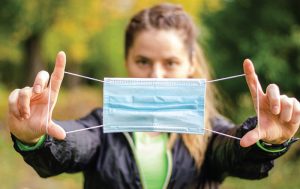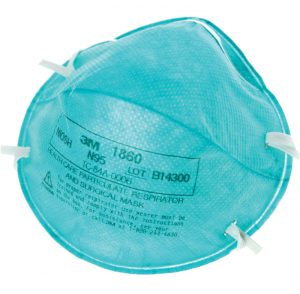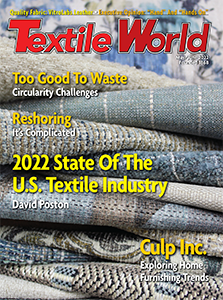
Manufacturing innovations will provide more reliable, affordable and adaptable protection in the face of the next pandemic.
By Behnam Pourdeyhimi, Technical Editor; Simon Schick; and Robert Groten
T他的世界卫生组织(WHO)最近发布了调查的结果,因为世界面临冠状病毒大流行,这是对与错的结果。一份长达86页的报告指出,“准备和反应链中的每个点都有薄弱的联系”。由WO任命的13名成员组成的小组称Covid-19-19为“可预防的灾难”。
调查引起的一些建议包括:
- 创建改进的疾病监测和警报系统,以一种可以打击诸如导致Covid-19的病毒之类的速度,以及谁发布信息并立即派遣专家任务的权限。
- 生产疫苗,诊断,治疗学和供应并确保其快速,公平交付的能力作为全球普通商品。
- 在低收入和中等收入国家,应紧急缩放和使用包括氧气在内的CoVID-19测试和治疗剂的使用。
Vice President Kamala Harris and U.S. Ambassador Linda Thomas-Greenfield recently opened a dialogue on pandemic preparedness aimed at learning the lessons learned from COVID-19, which was cohosted by Argentina, Norway, Japan, South Africa and the United States.
“The takeaway from this past year is clear: the world barely withstood this pandemic,” said Thomas-Greenfield addressing the global group comprised of political, public health and non-governmental organization leaders. “We must be ready for the next. We cannot continue to under-invest — after outbreaks, epidemics, and now a pandemic — in our capacity to prevent, detect, and respond to infectious disease threats.”
请注意,WHO并未专门解决个人防护设备(PPE)的挑战,而是专注于治疗方法等方面的挑战。上面的第二个子弹点是一个关键点 - 具有快速生产所需的东西并在全球且公平地提供这些耗材的能力。
When it comes to such products as face masks for example, it is difficult to produce them quickly and distribute them equitably to low- and middle-income countries. A paradigm shift is needed, and cloth masks are not the solution
Background
Protective mouth and nose coverage can be traced back to the beginning of the 20th century. In 1897, Carl Friedrich Flügge discussed the possibility of droplet infections originated by coughing and, interestingly, first identified the importance of social distancing1,2。讨论了霍乱,瘟疫和脑脊脑膜炎的空气传播,并认识到戴“嘴巴绷带”的重要性 - 一层棉纱布 - 被识别1。Cotton-based face masks were subsequently widely used during the Spanish flu pandemic of 1918-1920.
与这种简单的基于布的技术相反,当前的呼吸器和口罩以两种关键技术为中心:细,融化纤维;和静电电荷。融化本身可以追溯到1941年,当时该过程是第一次发明的3。It was immediately recognized that meltblowing can produce very fine fibers relative to traditional fiber melt spinning4。Meltblowing is a very economical, large-scale process that creates fiber diameters that range from sub-micron to a few microns.
Electrostatic charge enhances the particle interception efficiency of such fibers while producing a significantly lower overall pressure drop — a measure of the resistance that the air meets as it flows through the mask, which should be low enough that the effort required to breath is as normal as possible.
其他关键技术的重点是确保电荷密度最初高,更重要的是稳定。第一个“现代”面具是在1967年推出的5while the first respirator was patented in 1976. A critical development was the application of electrostatic charge to meltblown webs in 19806。导致当前使用的N95呼吸器的主要专利很快随之而来。第一项这样的专利于1980年颁发给总部位于明尼苏达州圣保罗的3M Co.7。1985年,3M开发了第一个现代的,杯形模制呼吸器8。
Ideal Filtration
Aerosols are a suspension of solid or liquid particles in a gas ranging in size from 2 nanometers (nm) to 100 micrometers. Bioaerosols are aerosols of biological origin, including viruses, bacteria and fungi. An ideal filter removes only the unwanted aerosol particles from the air and does it without creating a large pressure drop. There are four primary aerosol filtration mechanisms9(see Figure 1)。

空气流绕着纤维弯曲。Large particles are trapped by inertial impaction. Large particles have a high probability of impacting with a fiber because inertia causes them to deviate from the streamline. Inertial impaction is for large micro particles and becomes important at high and medium velocities. Very small particles also have a high probability of hitting a fiber due to Brownian motion. Brownian motion comes about as the particles collide with gas (air) molecules that are much smaller than the particles. This leads to a chaotic movement that is disordered and abrupt, which leads to diffusion. The capture mechanism for particles less than 100 nm is mainly due to diffusion.
However, larger sized particles — from approximately 100 nm to 400 nm with roughly 300 nm representing the most challenging particle size to capture — normally follow the airflow streamlines and are the most difficult to capture. The capture mechanism is due to interception as the particles may be intercepted by a fiber. This is where the electrostatic attraction becomes important. Oppositely charged particles are attracted to a charged fiber. This collection mechanism does not favor a certain particle size particularly but is most significant for the particles most difficult to capture.
纤维尺寸对于拦截捕获机制至关重要。如果纤维的尺寸相同或较小,则它们具有更有效拦截颗粒的趋势。这与高静电吸引力一起,导致了当今呼吸器和医疗面具的高过滤效率,它们对充电的融化结构进行了回复。
常规纺织纤维产生的布面膜采用更大的纤维(在大多数情况下大于15微米)缺乏静电电荷,并且结构会产生较大的间隙或孔。这些缝隙导致压力下降得多的局部区域,因此空气流将自然流向这些区域,并将气溶胶颗粒通过结构。这些口罩几乎没有呼吸保护。但是,它们在减少穿着者中排出的颗粒数量的数量方面很有用,这可能会导致病毒的扩散,即使它们可能对佩戴者没有太多保护。因此,通过减少佩戴者的鼻子和嘴中排出的液滴和气溶胶的数量,布料面罩可作为单个佩戴者的来源控制手段10。
Challenges During COVID-19
Mask filters are almost exclusively made from electrostatically charged polypropylene (PP) meltblown (MB) nonwovens. MB filters have fibers in the range of 0.5 to 5 microns in size and are therefore, fragile and must be protected by layers of spunbond (SB) PP made up of larger fibers — 15 to 25 microns — which provide mechanical protection for the MB filter layer.
总体供应链包括以下内容:
- MB织物制造商;
- SB fabric manufacturers;
- Mask converters who assemble the MB and SB fabrics into masks.
美国和全球在COVID-19大流行期间面临的双重挑战是MB织物的生产有限,并且缺乏将织物转化为口罩所需的基础设施。
MB和SB生产设施始终是定制的,既大又昂贵,需要大量的基础设施。设置新功能的提前时间通常大于10个月,而一台1.6米宽的融化机器的成本超过1000万美元。因此,即使在北美和欧盟的高收入地区,植物也无法更快地部署。在世界其他地区,不可能迅速提高,这就是为什么需要进行范式转变的原因。相比之下,面具转换更容易获得,相对便宜,不需要特殊的基础架构。
MB机器比其组件的总和要贵得多。工程专有技术,在某些情况下,知识产权会创造进入障碍。例如,融化就像一个过程一样简单。该技术的关键是控制产生的纤维均匀性的模具尖端。其余组件是现成的。但是,非编织工业围绕着大量,高速和低生产成本和自动化建立。这就是为什么非织造产业继续领导着生产力和创新的世界的原因。
诸如面罩和呼吸器等产品所需的是不同的解决方案。蒙版转换也是一个全自动的过程,宽度需求最多从19.5厘米(CM)到32厘米。请注意,例如,蒙版转换不需要特殊的基础架构,例如高海湾空间。如果设计了仅说40厘米宽的MB机器,则该过程仍然足够快,可以在成本低的同时提供许多蒙版转换机,并且不需要特殊的基础设施。以例如宽度为15英寸(38厘米)的Biax纤维膜试验线。有了一些小的更改,这可能会成为一台超级面膜过滤器生产机器,也可以与蒙版转换设备共处。还有其他较小的足迹线的例子,主要用作试点线。这些设计可以根据需要轻松复制和复制。

United States for mask production is
为三层surgical mask, not
the N95 mask. (Brian McGowan/Unsplash)
Lack Of Know-How, Equipment Availability
Another major challenge during the pandemic was lack of know-how. Meltblown structures require additives as charge enhancers and charge stabilizers. While some masterbatches are commercially available, some work and some do not. Also, while meltblown machinery is fully automated, the resulting fabric is impacted by process variables and therefore, a trial-and-error approach is required to establish the process conditions that lead to the desired performance characteristics. While there were companies in North America producing other meltblown products, switching to filter media was not a simple task.
Another challenge faced in North America was that no one was producing mask converting machinery before the pandemic. This was not because of a lack of expertise or capabilities, but rather driven by simple economics. Asian-made machines sold for as little as $30,000 to as much as $120,000 and could be delivered in a few weeks. The cost of the components in North America would be higher than the finished product and given that the machines look similar and operate similarly, the tendency has been to lean toward Asian-made machinery. Lack of technical support, an inadequate supply of parts, and the unreliability of the machinery, often led to delays and much higher production costs.
大约十六个月后,情况发生了变化。有一些新的融化设施,根据北卡罗来纳州卡里的非织造织物行业(INDA)的协会,自大流行开始以来,有70多家公司投资了面具转换设备。但是,许多新机械用于生产经典的三层手术面膜。在过去六个月中,廉价的亚洲手术面具淹没了市场,因此许多进行投资的公司是否能够竞争是值得怀疑的。反过来,这将导致安装MB容量的挑战。
There are far fewer N95 machines installed. In addition, medical masks and respirators are regulated by the National Institute for Occupational Safety and Health (NIOSH), the U.S. Food and Drug Administration (FDA) and the Occupational Safety and Health Administration (OSHA), and another barrier to entering the market today is the long lead time required for certification. Many companies have been waiting for certification for many months and the queue is not getting shorter. Certification also requires the development of a quality management system such as International Organization for Standardization (ISO) or good manufacturing practice (GMP) certification — additional barriers to market entry.
下一个大流行呢?
It is not a question of if, but when, another global pandemic happens. In the absence of policies that encourage domestic manufacturing of PPE and other critical products, the shortage situation in the United States likely will be no different. In the absence of democratized manufacturing, low-income countries will continue to be at a disadvantage.
PPE制造业的现状不足以使美国免受下一次病毒爆发的限制。进一步的制造创新是通往更可靠,负担得起,适应能力保护的途径。布面罩将不是解决方案,并且可能会使用新的ASTM 3502或同等用品来调节。
北卡罗来纳州罗利市的Nonwovens Institute及其合作伙伴正在制定制造策略和教育计划,以帮助建立可扩展且易于重现的确定最低制造标准。
参考:
1Flügge, C. Ueber Luftinfection. Zeitschr. f. Hygiene. 25, 179–224 (1897). https://doi.org/10.1007/BF02220473
2C. Flügge, The spread of phthisis through dusty sputum and through droplets that are sprayed out when coughing, Journal of Hygiene and Infectious Diseases volume 30 , pages107 – 124 ( 1899 )
3JG McCulloch, The history of the development of melt blowing technology International Nonwovens Journal, 1999
4Wente, V.A. , Naval Research Laboratory, Report 4364, Manufacture of Superfine Fibers. May 25, 1954.
5U.S. Patent 3,333,585
6美国专利3,971,373A
7美国专利4,215,682a
8U.S. Patent 4,536,440A
9Pourdeyhimi,Schick和Groten,单层纺织品的过滤效率用于呼吸保护,《科学与医学杂志》,第3卷第2卷(2021)
10Pourdeyhimi, Schick and Groten, Respiratory Effectiveness of Cloth Masks, The Journal of Science and Medicine, Vol 2 No 4 (2021)
Editor’s Note: Dr. Behnam Pourdeyhimi is associate dean for Industry Research and Extension, William A. Klopman Distinguished Professor of Materials, professor of Chemical and Biomolecular Engineering and Biomedical Engineering, and executive director, The Nonwovens Institute (NWI), Wilson College of Textiles, North Carolina State University, Raleigh, N.C.; Simon Schick was a masters student at NWI and NC State; and Robert Groten is a professor with Germany-based Hochschule Niederrhein University of Applied Sciences, Germany, and an adjunct professor at NC State.
July/August 2021




